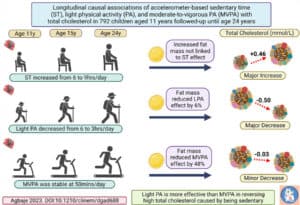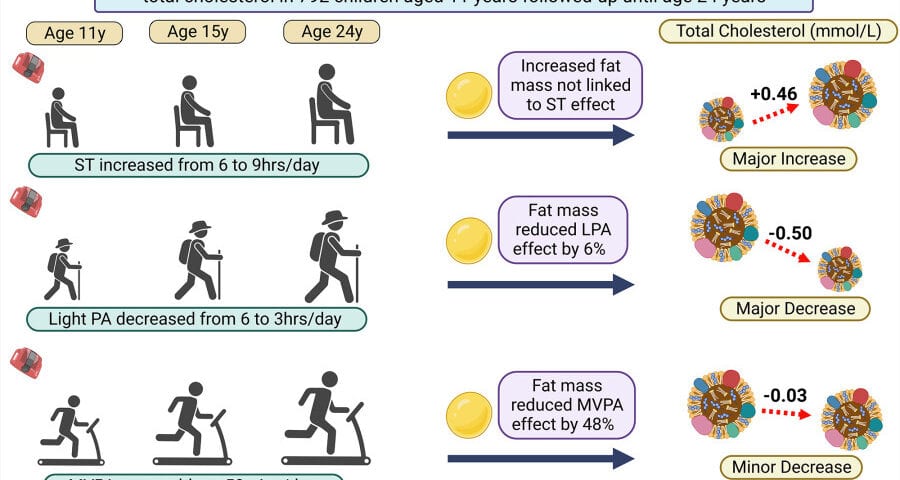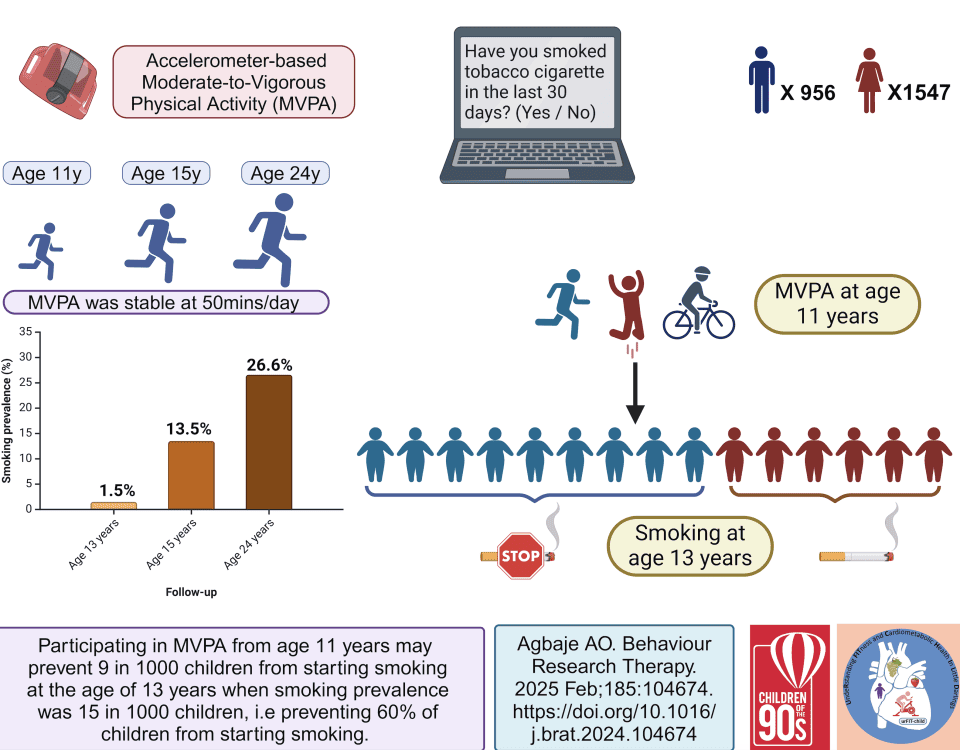
Light physical activity may reverse childhood obesity caused by being sedentary
December 18, 2023
Sedentary Behaviour Epidemiology
January 9, 2024Congratulations to Dr. Andrew Agbaje and colleagues for their new publication entitled “Associations of Sedentary Time and Physical Activity From Childhood With Lipids: A 13-Year Mediation and Temporal Study”. This study has also been getting a lot of attention in the media! A big thank you also goes to Dr. Andrew Agbaje who provided this blog post. This press release was originally published by the University of Eastern Finland which can be found here. Full link to the article can be found here.
Increased sedentary time from childhood through young adulthood significantly increased cholesterol levels in a new follow-up study. However, the results also showed that light physical activity (LPA) may completely reverse the adverse process. Moderate-to-vigorous physical activity (MVPA) may also reduce cholesterol levels, but its effect is diminished by body fat. The study was conducted in collaboration between the University of Bristol in the UK, the University of Exeter in the UK, and the University of Eastern Finland, and the results were published in the Journal of Clinical Endocrinology & Metabolism.
Elevated cholesterol and dyslipidaemia from childhood and adolescence have been associated with premature death in the mid-forties and subclinical atherosclerosis and cardiac damage in the mid-twenties. The prevalence of elevated cholesterol and dyslipidaemia is 20% in teenagers without genetic inheritance which increased to 25% by mid-twenties.
To reduce the risk of dyslipidaemia, experts have proposed universal paediatric lipid screening including the potential adoption of an “adolescent cholesterol passport” to help track the increase in cholesterol levels and initiate a timely preventive treatment in the young population.
Healthy lifestyles are considered important in the prevention of dyslipidaemia. One of the potential modifiable factors for lowering cholesterol apart from diet is movement behaviour.
The long-term effects of sedentary time, LPA, and MVPA, objectively measured with an accelerometer from childhood on cholesterol levels, have not been previously examined. The present study which used data from the University of Bristol study Children of the 90s (also known as the Avon Longitudinal Study of Parents and Children) included 792 children aged 11 years who were followed up until age 24 years, with a total follow-up time of approximately 13 years.
Accelerometer measures of sedentary time, LPA, and MVPA were collected at ages 11, 15, and 24 years. High-density lipoprotein cholesterol, low-density lipoprotein cholesterol, triglyceride, and total cholesterol were repeatedly measured at ages 15, 17, and 24 years. These children also had repeated measurement of dual-energy Xray absorptiometry assessment of total body fat mass and muscle mass, as well as fasting blood glucose, insulin, and high sensitivity C-reactive protein, with smoking status, socio-economic status, and family history of cardiovascular disease.
During the 13-year follow-up, sedentary time increased from approximately 6 hours a day to 9 hours a day. LPA decreased from 6 hours a day to 3 hours a day while MVPA was relatively stable around 50 minutes a day from childhood until young adulthood. The average increase in total cholesterol was 0.69 mmol/l. It was observed that accumulated sedentary time from childhood contributed 67% of the increase in total cholesterol without any influence from body fat.
An average of 4.5 hours a day of LPA from childhood through young adulthood causally decreased total cholesterol by (-0.53 mmol/l), however, body fat mass could reduce the effect of LPA on total cholesterol by up to 6%. Approximately 50 minutes a day of MVPA from childhood was also associated with slightly reduced total cholesterol (-0.05 mmol/L), but total body fat mass decreased the effect of MVPA on total cholesterol by up to 48%. Importantly, the increase in fat mass neutralised the small effect of MVPA on total cholesterol.
“We are seeing for the first time that LPA from childhood may be better than MVPA at reversing the adverse effect of sedentary time on elevated cholesterol and dyslipidaemia. An increase in both muscle and fat mass is physiological phenomenon in youth, so it is astonishing that the increase in fat mass significantly decreased the effect of MVPA on lowering cholesterol. An excessive increase in fat mass is never healthy, and future research may examine optimal approaches to prevent it,” says Andrew Agbaje, an award-winning physician and paediatric clinical epidemiologist at the University of Eastern Finland.
“It is quite unprecedented that increased sedentary time from childhood contributed two-thirds of the increase in cholesterol level before mid-twenties. We have also recently reported that LPA promotes healthy hearts and lowers inflammation in the young population better than MVPA. These findings emphasise that LPA may be a critical tool in primordially preventing elevated cholesterol and dyslipidaemia from early life, and in this regard, it could be considerably more effective than MVPA.”
“Although the World Health Organization has recommended that children and adolescents should accumulate on average 60 minutes of MVPA per day and reduce sedentary time, guidelines on engaging in LPA in the young population are still lacking. Our recent studies are now contributing novel evidence on the incredible health importance of LPA. Therefore, public health experts, paediatricians, and health policymakers should encourage more participation in LPA from childhood,” Agbaje continues.
Dr Agbaje’s research group (urFIT-child) is supported by research grants from Jenny and Antti Wihuri Foundation, the Finnish Cultural Foundation Central Fund, the Finnish Cultural Foundation North Savo Regional Fund, the Orion Research Foundation, the Aarne Koskelo Foundation, the Antti and Tyyne Soininen Foundation, the Paulo Foundation, the Yrjö Jahnsson Foundation, the Paavo Nurmi Foundation, the Finnish Foundation for Cardiovascular Research, Ida Montin Foundation, the Foundation for Pediatric Research, and Alfred Kordelin Foundation.
For further information, please contact:
Andrew Agbaje, MD, MPH, FESC, Cert. Clinical Research (Harvard), Principal Investigator (urFIT-child). Institute of Public Health and Clinical Nutrition, School of Medicine, University of Eastern Finland, Kuopio, Finland. andrew.agbaje@uef.fi, +358 46 896 5633
Honorary Research Fellow – Children’s Health and Exercise Research Centre, Public Health and Sports Sciences Department, Faculty of Health and Life Sciences, University of Exeter, Exeter, UK. a.agbaje@exeter.ac.uk
https://uefconnect.uef.fi/en/person/andrew.agbaje/
Link to the article:
Agbaje AO. Associations of Sedentary Time and Physical Activity From Childhood With Lipids: A 13-Year Mediation and Temporal Study. J Clin Endocrinol Metab. 2023 Dec 14:dgad688. https://doi.org/10.1210/clinem/dgad688
About Children of the 90s
Based at the University of Bristol, Children of the 90s, also known as the Avon Longitudinal Study of Parents and Children (ALSPAC), is a long-term health research project that enrolled more than 14,000 pregnant women in 1991 and 1992. It has been following the health and development of the parents, their children and now their grandchildren in detail ever since. It receives core funding from the Medical Research Council, the Wellcome Trust and the University of Bristol.
About the University of Eastern Finland
The University of Eastern Finland, UEF, is the most multidisciplinary university in Finland. The university’s high standard of interdisciplinary research and education respond to global challenges, building a sustainable future. Research conducted at UEF is ranked among the best in the world in several fields. The university is home to 16,000 students and 3,200 staff.
Webpage: urFIT-CHILD Research group

Increased sedentary time from childhood through young adulthood may potentially cause elevated cholesterol and dyslipidaemia in adolescence and young adulthood, however, light physical activity can significantly reverse worsening dyslipidaemia. The increase in fat mass from childhood remarkably dampened the effect of moderate-to-vigorous physical activity on lowering cholesterol. Image: Andrew Agbaje.




